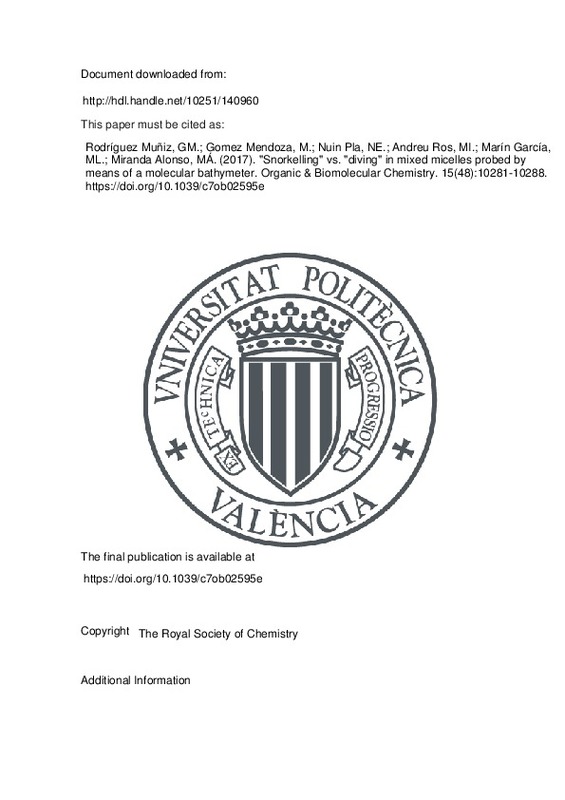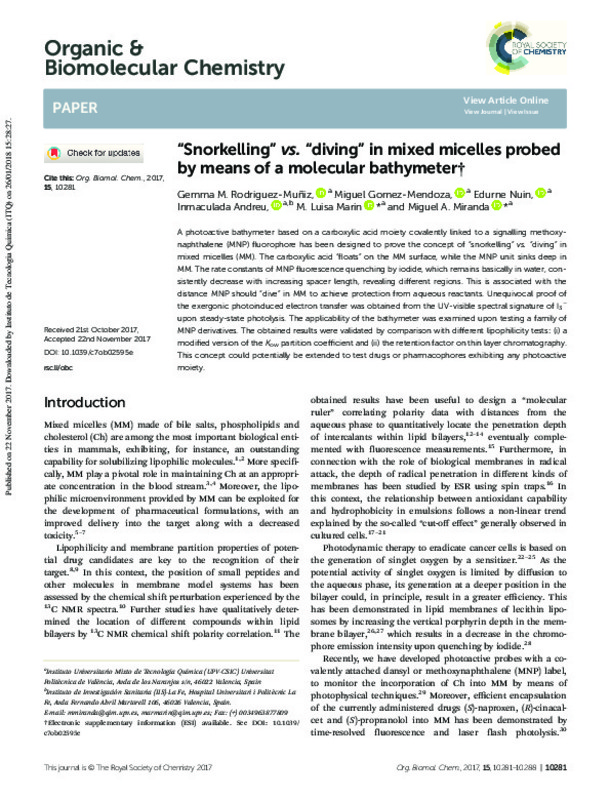JavaScript is disabled for your browser. Some features of this site may not work without it.
Buscar en RiuNet
Listar
Mi cuenta
Estadísticas
Ayuda RiuNet
Admin. UPV
"Snorkelling" vs. "diving" in mixed micelles probed by means of a molecular bathymeter
Mostrar el registro sencillo del ítem
Ficheros en el ítem
| dc.contributor.author | Rodríguez Muñiz, Gemma María
|
es_ES |
| dc.contributor.author | Gomez Mendoza, Miguel
|
es_ES |
| dc.contributor.author | Nuin Pla, Neus Edurne
|
es_ES |
| dc.contributor.author | Andreu Ros, María Inmaculada
|
es_ES |
| dc.contributor.author | Marín García, Mª Luisa
|
es_ES |
| dc.contributor.author | Miranda Alonso, Miguel Ángel
|
es_ES |
| dc.date.accessioned | 2020-04-17T12:51:43Z | |
| dc.date.available | 2020-04-17T12:51:43Z | |
| dc.date.issued | 2017 | es_ES |
| dc.identifier.issn | 1477-0520 | es_ES |
| dc.identifier.uri | http://hdl.handle.net/10251/140960 | |
| dc.description.abstract | [EN] A photoactive bathymeter based on a carboxylic acid moiety covalently linked to a signalling methoxynaphthalene (MNP) fluorophore has been designed to prove the concept of "snorkelling" vs. "diving" in mixed micelles (MM). The carboxylic acid "floats" on the MM surface, while the MNP unit sinks deep in MM. The rate constants of MNP fluorescence quenching by iodide, which remains basically in water, consistently decrease with increasing spacer length, revealing different regions. This is associated with the distance MNP should "dive" in MM to achieve protection from aqueous reactants. Unequivocal proof of the exergonic photoinduced electron transfer was obtained from the UV-visible spectral signature of I-3(-) upon steady-state photolysis. The applicability of the bathymeter was examined upon testing a family of MNP derivatives. The obtained results were validated by comparison with different lipophilicity tests: (i) a modified version of the K-ow partition coefficient and (ii) the retention factor on thin layer chromatography. This concept could potentially be extended to test drugs or pharmacophores exhibiting any photoactive moiety. | es_ES |
| dc.description.sponsorship | Financial support from the Spanish Government (SEV-2016-0683), Red RETICS de Investigacion de Reacciones Adversas a Alergenos y Farmacos (RIRAAF), Instituto de Salud Carlos III (RD012/0013, RD16/0006/0030, FIS PI16/01877), VLC-Campus and the Generalitat Valenciana (Prometeo Program) is gratefully acknowledged. | es_ES |
| dc.language | Inglés | es_ES |
| dc.publisher | The Royal Society of Chemistry | es_ES |
| dc.relation.ispartof | Organic & Biomolecular Chemistry | es_ES |
| dc.rights | Reserva de todos los derechos | es_ES |
| dc.subject.classification | QUIMICA ANALITICA | es_ES |
| dc.subject.classification | QUIMICA ORGANICA | es_ES |
| dc.title | "Snorkelling" vs. "diving" in mixed micelles probed by means of a molecular bathymeter | es_ES |
| dc.type | Artículo | es_ES |
| dc.identifier.doi | 10.1039/c7ob02595e | es_ES |
| dc.relation.projectID | info:eu-repo/grantAgreement/MINECO//SEV-2016-0683/ | es_ES |
| dc.relation.projectID | info:eu-repo/grantAgreement/ISCIII//RD012%2F0013/ | es_ES |
| dc.relation.projectID | info:eu-repo/grantAgreement/MINECO//RD16%2F0006%2F0030/ES/Asma, Reacciones Adversas y Alérgicas (ARADYAL)/ | es_ES |
| dc.relation.projectID | info:eu-repo/grantAgreement/MINECO//PI16%2F01877/ES/Estrategia integrada de fotodiagnóstico combinando evaluación clínica, ensayos biológicos y estudios mecanísticos/ | es_ES |
| dc.rights.accessRights | Abierto | es_ES |
| dc.contributor.affiliation | Universitat Politècnica de València. Departamento de Química - Departament de Química | es_ES |
| dc.description.bibliographicCitation | Rodríguez Muñiz, GM.; Gomez Mendoza, M.; Nuin Pla, NE.; Andreu Ros, MI.; Marín García, ML.; Miranda Alonso, MÁ. (2017). "Snorkelling" vs. "diving" in mixed micelles probed by means of a molecular bathymeter. Organic & Biomolecular Chemistry. 15(48):10281-10288. https://doi.org/10.1039/c7ob02595e | es_ES |
| dc.description.accrualMethod | S | es_ES |
| dc.relation.publisherversion | https://doi.org/10.1039/c7ob02595e | es_ES |
| dc.description.upvformatpinicio | 10281 | es_ES |
| dc.description.upvformatpfin | 10288 | es_ES |
| dc.type.version | info:eu-repo/semantics/publishedVersion | es_ES |
| dc.description.volume | 15 | es_ES |
| dc.description.issue | 48 | es_ES |
| dc.relation.pasarela | S\347419 | es_ES |
| dc.contributor.funder | Generalitat Valenciana | es_ES |
| dc.contributor.funder | Instituto de Salud Carlos III | es_ES |
| dc.contributor.funder | Universitat Politècnica de València | es_ES |
| dc.contributor.funder | Ministerio de Economía y Competitividad | es_ES |
| dc.description.references | Porter, C. J. H., Trevaskis, N. L., & Charman, W. N. (2007). Lipids and lipid-based formulations: optimizing the oral delivery of lipophilic drugs. Nature Reviews Drug Discovery, 6(3), 231-248. doi:10.1038/nrd2197 | es_ES |
| dc.description.references | Hammad, M. ., & Müller, B. . (1998). Increasing drug solubility by means of bile salt–phosphatidylcholine-based mixed micelles. European Journal of Pharmaceutics and Biopharmaceutics, 46(3), 361-367. doi:10.1016/s0939-6411(98)00037-x | es_ES |
| dc.description.references | Nagadome, S., Numata, O., Sugihara, G., Sasaki, Y., & Igimi, H. (1995). Solubilization and precipitation of cholesterol in aqueous solution of bile salts and their mixtures. Colloid & Polymer Science, 273(7), 675-680. doi:10.1007/bf00652260 | es_ES |
| dc.description.references | Hofmann, A. F. (1999). The Continuing Importance of Bile Acids in Liver and Intestinal Disease. Archives of Internal Medicine, 159(22), 2647. doi:10.1001/archinte.159.22.2647 | es_ES |
| dc.description.references | Ding, J., Sun, Y., Li, J., Wang, H., & Mao, S. (2017). Enhanced blood–brain barrier transport of vinpocetine by oral delivery of mixed micelles in combination with a message guider. Journal of Drug Targeting, 25(6), 532-540. doi:10.1080/1061186x.2017.1289541 | es_ES |
| dc.description.references | Lasic, D. D. (1992). Mixed micelles in drug delivery. Nature, 355(6357), 279-280. doi:10.1038/355279a0 | es_ES |
| dc.description.references | Cheng, L., Kamkaew, A., Sun, H., Jiang, D., Valdovinos, H. F., Gong, H., … Cai, W. (2016). Dual-Modality Positron Emission Tomography/Optical Image-Guided Photodynamic Cancer Therapy with Chlorin e6-Containing Nanomicelles. ACS Nano, 10(8), 7721-7730. doi:10.1021/acsnano.6b03074 | es_ES |
| dc.description.references | Lipinski, C. A., Lombardo, F., Dominy, B. W., & Feeney, P. J. (1997). Experimental and computational approaches to estimate solubility and permeability in drug discovery and development settings. Advanced Drug Delivery Reviews, 23(1-3), 3-25. doi:10.1016/s0169-409x(96)00423-1 | es_ES |
| dc.description.references | Beaumont, K., Schmid, E., & Smith, D. A. (2005). Oral delivery of G protein-coupled receptor modulators: An explanation for the observed class difference. Bioorganic & Medicinal Chemistry Letters, 15(16), 3658-3664. doi:10.1016/j.bmcl.2005.05.042 | es_ES |
| dc.description.references | Al-Abdul-Wahid, M. S., Neale, C., Pomès, R., & Prosser, R. S. (2009). A Solution NMR Approach to the Measurement of Amphiphile Immersion Depth and Orientation in Membrane Model Systems. Journal of the American Chemical Society, 131(18), 6452-6459. doi:10.1021/ja808964e | es_ES |
| dc.description.references | Afri, M., Frimer, A. A., & Cohen, Y. (2004). Active oxygen chemistry within the liposomal bilayer. Chemistry and Physics of Lipids, 131(1), 123-133. doi:10.1016/j.chemphyslip.2004.04.006 | es_ES |
| dc.description.references | Cohen, Y., Bodner, E., Richman, M., Afri, M., & Frimer, A. A. (2008). NMR-based molecular ruler for determining the depth of intercalants within the lipid bilayer. Chemistry and Physics of Lipids, 155(2), 98-113. doi:10.1016/j.chemphyslip.2008.07.004 | es_ES |
| dc.description.references | Cohen, Y., Afri, M., & Frimer, A. A. (2008). NMR-based molecular ruler for determining the depth of intercalants within the lipid bilayer. Chemistry and Physics of Lipids, 155(2), 114-119. doi:10.1016/j.chemphyslip.2008.07.007 | es_ES |
| dc.description.references | Afri, M., Alexenberg, C., Aped, P., Bodner, E., Cohen, S., Ejgenburg, M., … Frimer, A. A. (2014). NMR-based molecular ruler for determining the depth of intercalants within the lipid bilayer. Chemistry and Physics of Lipids, 184, 105-118. doi:10.1016/j.chemphyslip.2014.07.007 | es_ES |
| dc.description.references | Afri, M., Naqqash, M. E., & Frimer, A. A. (2011). Using fluorescence to locate intercalants within the lipid bilayer of liposomes, bioliposomes and erythrocyte ghosts. Chemistry and Physics of Lipids, 164(8), 759-765. doi:10.1016/j.chemphyslip.2011.09.002 | es_ES |
| dc.description.references | Bodner, E., Afri, M., & Frimer, A. A. (2010). Determining radical penetration into membranes using ESR splitting constants. Free Radical Biology and Medicine, 49(3), 427-436. doi:10.1016/j.freeradbiomed.2010.04.029 | es_ES |
| dc.description.references | Laguerre, M., López Giraldo, L. J., Lecomte, J., Figueroa-Espinoza, M.-C., Baréa, B., Weiss, J., … Villeneuve, P. (2009). Chain Length Affects Antioxidant Properties of Chlorogenate Esters in Emulsion: The Cutoff Theory Behind the Polar Paradox. Journal of Agricultural and Food Chemistry, 57(23), 11335-11342. doi:10.1021/jf9026266 | es_ES |
| dc.description.references | Laguerre, M., López Giraldo, L. J., Lecomte, J., Figueroa-Espinoza, M.-C., Baréa, B., Weiss, J., … Villeneuve, P. (2010). Relationship between Hydrophobicity and Antioxidant Ability of «Phenolipids» in Emulsion: A Parabolic Effect of the Chain Length of Rosmarinate Esters. Journal of Agricultural and Food Chemistry, 58(5), 2869-2876. doi:10.1021/jf904119v | es_ES |
| dc.description.references | Aliaga, C., Bravo-Moraga, F., Gonzalez-Nilo, D., Márquez, S., Lühr, S., Mena, G., & Rezende, M. C. (2016). Location of TEMPO derivatives in micelles: subtle effect of the probe orientation. Food Chemistry, 192, 395-401. doi:10.1016/j.foodchem.2015.07.036 | es_ES |
| dc.description.references | Aliaga, C., López de Arbina, A., & Rezende, M. C. (2016). «Cut-off» effect of antioxidants and/or probes of variable lipophilicity in microheterogeneous media. Food Chemistry, 206, 119-123. doi:10.1016/j.foodchem.2016.03.024 | es_ES |
| dc.description.references | Lopez de Arbina, A., Rezende, M. C., & Aliaga, C. (2017). Cut-off effect of radical TEMPO derivatives in olive oil-in-water emulsions. Food Chemistry, 224, 342-346. doi:10.1016/j.foodchem.2016.12.058 | es_ES |
| dc.description.references | Agostinis, P., Berg, K., Cengel, K. A., Foster, T. H., Girotti, A. W., Gollnick, S. O., … Golab, J. (2011). Photodynamic therapy of cancer: An update. CA: A Cancer Journal for Clinicians, 61(4), 250-281. doi:10.3322/caac.20114 | es_ES |
| dc.description.references | Kamkaew, A., Lim, S. H., Lee, H. B., Kiew, L. V., Chung, L. Y., & Burgess, K. (2013). BODIPY dyes in photodynamic therapy. Chem. Soc. Rev., 42(1), 77-88. doi:10.1039/c2cs35216h | es_ES |
| dc.description.references | Yano, S., Hirohara, S., Obata, M., Hagiya, Y., Ogura, S., Ikeda, A., … Joh, T. (2011). Current states and future views in photodynamic therapy. Journal of Photochemistry and Photobiology C: Photochemistry Reviews, 12(1), 46-67. doi:10.1016/j.jphotochemrev.2011.06.001 | es_ES |
| dc.description.references | Dolmans, D. E. J. G. J., Fukumura, D., & Jain, R. K. (2003). Photodynamic therapy for cancer. Nature Reviews Cancer, 3(5), 380-387. doi:10.1038/nrc1071 | es_ES |
| dc.description.references | Bronshtein, I., Afri, M., Weitman, H., Frimer, A. A., Smith, K. M., & Ehrenberg, B. (2004). Porphyrin Depth in Lipid Bilayers as Determined by Iodide and Parallax Fluorescence Quenching Methods and Its Effect on Photosensitizing Efficiency. Biophysical Journal, 87(2), 1155-1164. doi:10.1529/biophysj.104.041434 | es_ES |
| dc.description.references | Lavi, A., Weitman, H., Holmes, R. T., Smith, K. M., & Ehrenberg, B. (2002). The Depth of Porphyrin in a Membrane and the Membrane’s Physical Properties Affect the Photosensitizing Efficiency. Biophysical Journal, 82(4), 2101-2110. doi:10.1016/s0006-3495(02)75557-4 | es_ES |
| dc.description.references | Chattopadhyay, A., & London, E. (1987). Parallax method for direct measurement of membrane penetration depth utilizing fluorescence quenching by spin-labeled phospholipids. Biochemistry, 26(1), 39-45. doi:10.1021/bi00375a006 | es_ES |
| dc.description.references | Nuin, E., Gómez-Mendoza, M., Andreu, I., Marin, M. L., & Miranda, M. A. (2012). New Photoactive Compounds To Probe Cholic Acid and Cholesterol inside Mixed Micelles. Organic Letters, 15(2), 298-301. doi:10.1021/ol303201y | es_ES |
| dc.description.references | Nuin, E., Gomez-Mendoza, M., Marin, M. L., Andreu, I., & Miranda, M. A. (2013). Influence of Drug Encapsulation within Mixed Micelles on the Excited State Dynamics and Accessibility to Ionic Quenchers. The Journal of Physical Chemistry B, 117(32), 9327-9332. doi:10.1021/jp404353u | es_ES |
| dc.description.references | Gomez-Mendoza, M., Nuin, E., Andreu, I., Marin, M. L., & Miranda, M. A. (2012). Photophysical Probes To Assess the Potential of Cholic Acid Aggregates as Drug Carriers. The Journal of Physical Chemistry B, 116(34), 10213-10218. doi:10.1021/jp304708y | es_ES |
| dc.description.references | Boschloo, G., & Hagfeldt, A. (2009). Characteristics of the Iodide/Triiodide Redox Mediator in Dye-Sensitized Solar Cells. Accounts of Chemical Research, 42(11), 1819-1826. doi:10.1021/ar900138m | es_ES |
| dc.description.references | Gardner, J. M., Abrahamsson, M., Farnum, B. H., & Meyer, G. J. (2009). Visible Light Generation of Iodine Atoms and I−I Bonds: Sensitized I−Oxidation and I3−Photodissociation. Journal of the American Chemical Society, 131(44), 16206-16214. doi:10.1021/ja905021c | es_ES |
| dc.description.references | Sangster, J. (1989). Octanol‐Water Partition Coefficients of Simple Organic Compounds. Journal of Physical and Chemical Reference Data, 18(3), 1111-1229. doi:10.1063/1.555833 | es_ES |









